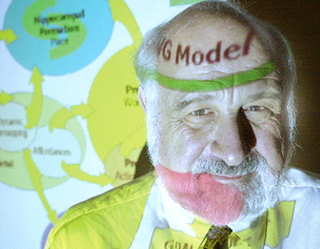非常抱歉,
你要访问的页面不存在,
非常抱歉,
你要访问的页面不存在,
非常抱歉,
你要访问的页面不存在,
验证码:

职称:Fletcher Jones Professor of Computer Science University Professor Professor of Biological Sciences, Biomedical Engineering, Electrical Engineering, Neuroscience and Psychology Director, USC Brain Project
所属学校:University of Southern California
所属院系:Neuroscience
所属专业:Neuroscience
联系方式: (213) 740-9220
B.Sc. (Hons.) First Class Honours in Pure Mathematics, University of Sydney, Australia, 1960. Ph.D. Mathematics, Massachusetts Institute of Technology, 1963.
The thrust of Michael Arbib's work is expressed in the title of his first book, Brains, Machines and Mathematics (McGraw-Hill, 1964). The brain is not a computer in the current technological sense, but he has based his career on the argument that we can learn much about machines from studying brains, and much about brains from studying machines. He has thus always worked for an interdisciplinary environment in which computer scientists and engineers can talk to neuroscientists and cognitive scientists. His primary research focus is on the coordination of perception and action. This is tackled at two levels: via schema theory, which is applicable both in top-down analyses of brain function and human cognition as well as in studies of machine vision and robotics; and through the detailed analysis of neural networks, working closely with the experimental findings of neuroscientists on humans and monkeys. He is also engaged in research on the evolution of brain mechanisms for human language, pursuing the Mirror System Hypothesis that links language parity (the fact that what the speaker intends is roughly what the hearer understands) to the properties of the mirror system for grasping -- neurons active for both the execution and observation of actions -- to explain (amongst many other things) why human brains can acquire sign language as readily as speech. A new interest is working with architects to better understand the neuroscience of the architectural experience and to develop a new field of neuromorphic architecture, "brains for buildings". The author or editor of almost 40 books, Arbib has most recently edited "Who Needs Emotions? The Brain Meets the Robot" (with Jean-Marc Fellous, Oxford University Press, 2005) and "From Action to Language via the Mirror System" (Cambridge University Press, 2006).